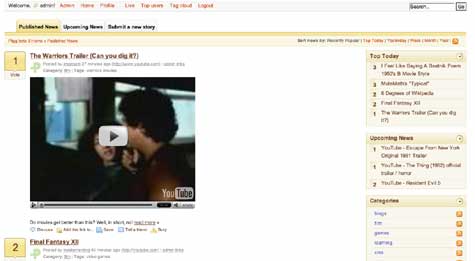
I installed the digg-clone Pligg on my bluehost account here, and all’s well so far. The install is very straight forward: create a mysql database, change some folder/file permissions, and click on /install.php. It has a few out-of-the-box module/plugins like including embedded videos in a submitted story which is a nice feature. And while the development of new themes is underway, I tried out a few of them but found they were borking -so for now I am just sticking with the default. I had some “fellow travelers” at DTLT register and try the service out (if you are interested in giving it a test run feel free) and it seems to be working swimmingly. Now, I just have to start conceptualizing some ways to use such a space in the classroom, departmental sites, or even more broadly around the campus. Any ideas?


How about in a seminar where you want students to collect, submit, and comment on various articles or sites related to a particular topic? [I’m thinking in particular of Steve’s FSEM on globalization here, though I’m working on ways to make less current topics (such as the experiences American veterans in the early 18th, 19th, and 20th Centuries) work too.
Or, what about as a ranked repository of campus news stories (either in the student paper or from the official releases) that students/faculty/community members would bring to the top through relevance or interest? [What about Middlesell? It seems ideal for such an installation.]
I have other ideas about how to use it, but they’re even less formed at the moment. It’s clearly a tool with lots of possibilities for unleashing student participation and creation, especially in the aggregate.
Jeff,
I’m glad you see the use of such a tool. I entirely agree with you, I is a quick and easy way for generating participation in the aggregate. I really like the idea of a participatory community sharing archival resources via images, links, and maybe even videos. Similar to del.icio.us (even if less malleable and effective) an application like this can provide a space where students can visually engage, share, and comment upon resources in dynamic ways by voting, burying, creating categories, etc. I am particularly interested in allowing a group of students to converge around an install and allowing them to forge an identity for the service for themselves. Brian Lamb linked to a participatory student-driven blog at UBC on Iranian History and Culture and it is really impressive. What would a group of history students playing with such a service look like as opposed to a group of biology students or business students? How would a service like this be used to share work in several classes throughout a department? This could be an interesting place for some cross pollination of ideas and topics -or even disciplines.
Alternatively, Patrick suggested that the foreign language department students use it to create a quick and easy repository of foreign language resources from podcasts or videos on YouTube, etc. It seems easy enough that it just might work!
Now, let me think -who on Earth could we get to test something like this in the classroom? I imagine they would have to be a bit adventurous, have recently got some job security, and be ready to take a risk or two when it comes to technology. Hmm, no one’s coming to mind at the moment. 😉
Pligg is a fantastic script for this type of thing, it has a lot of potential and hopefully it will continue to be developed.
Good luck.